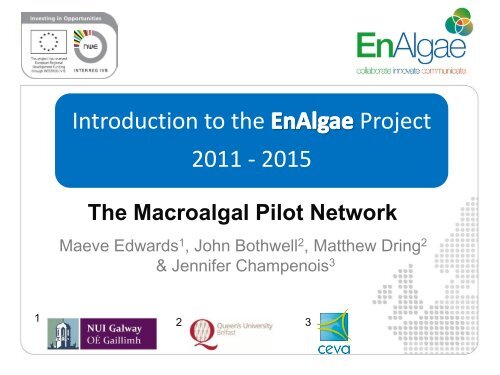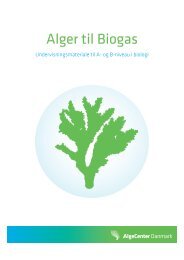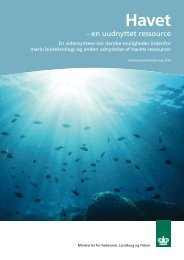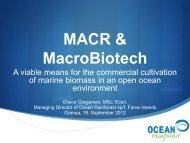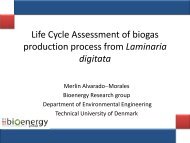EnAlgae Macroalgal Pilot Network - Algecenter Danmark
EnAlgae Macroalgal Pilot Network - Algecenter Danmark
EnAlgae Macroalgal Pilot Network - Algecenter Danmark
You also want an ePaper? Increase the reach of your titles
YUMPU automatically turns print PDFs into web optimized ePapers that Google loves.
Introduction to the Project<br />
2011 - 2015<br />
The <strong>Macroalgal</strong> <strong>Pilot</strong> <strong>Network</strong><br />
Maeve Edwards 1 , John Bothwell 2 , Matthew Dring 2<br />
& Jennifer Champenois 3<br />
1 2 3
<strong>EnAlgae</strong> (Energetic Algae )<br />
• <strong>EnAlgae</strong> is a 4 year, €14.6M Strategic Initiative of<br />
the INTERREG IVB North West Europe (NWE)<br />
Programme, combining the expertise and<br />
resources of 19 Partners plus 14 Observers<br />
encompassing 7 EU Member States.<br />
Overall aim: To develop sustainable pathways for<br />
algal bioenergy in NW Europe<br />
Website: www.enalgae.eu
<strong>EnAlgae</strong> aims to:<br />
• Improve current methods of culturing both macro- and<br />
micro-algae, through the improvement of pilot plants.<br />
• Integrate with existing industrial, agricultural and municipal<br />
processes to capture and remediate flue gas CO 2 and soluble<br />
aqueous wastes.<br />
• Address the cultural barriers which stand in the way of<br />
algal bioproduct use in Europe.
<strong>EnAlgae</strong> Partnership
<strong>EnAlgae</strong> WP1 –<br />
NW European <strong>Network</strong> of Algal <strong>Pilot</strong>s<br />
A trans-national network maximising the impact of pilot<br />
scale facilities via effective information exchange and<br />
knowledge transfer.<br />
Create a network of 9 algal<br />
pilot facilities across NWE<br />
Up-to-date inventory of<br />
facilities in NWE and<br />
standardised data<br />
management system<br />
Develop best practice for<br />
algal strain exploitation<br />
Demonstrate pilot plants to a<br />
diverse range of partners,<br />
observers, and stakeholders
<strong>EnAlgae</strong> WP2 – Sustainable algae to<br />
energy market for NW Europe<br />
Identify political, economic, social and technological<br />
opportunities for algal bioenergy within NWE, delivering<br />
information for policy-makers, industry and investors.<br />
Assess market and<br />
economics; assess<br />
technology expertise<br />
Define regulatory &<br />
planning issues<br />
Undertake policy<br />
landscaping analysis<br />
Identify life-cycle analysis<br />
and sustainability issues
<strong>EnAlgae</strong> WP3 - Decision support tool for<br />
practitioners, policy makers and investors<br />
Combine information from the algal-bioenergy delivery chain into<br />
an ICT tool to guide decision making, identify knowledge gaps and<br />
provide a roadmap for the sustainable deployment of algal<br />
bioenergy in NWE.<br />
Develop modular<br />
ICT framework to<br />
capture general<br />
and specialised<br />
process knowledge<br />
Validate tool using<br />
different algal<br />
biomass production<br />
scenarios<br />
Launch ICT tool via<br />
online Algal<br />
Information<br />
<strong>Network</strong> (AIN)
<strong>EnAlgae</strong> WP1 –<br />
NW European <strong>Network</strong> of Algal <strong>Pilot</strong>s<br />
1. UK. New algal innovation centre demonstrating a range of<br />
microalgal growth systems (open & closed)<br />
2. BE. New portable mixed microalgae / bacteria bioreactor<br />
3. IE. New large scale open-sea macroalgal cultivation (longlines)<br />
4. UK. Upgrade of microalgal flue gas CO 2 capture facility<br />
5. DE. New microalgae production attached to advanced<br />
aquaculture<br />
6. NL. New outdoor microalgae production (open ponds)<br />
7. FR. Upgrade of macroalgal raceways + longlines<br />
8. UK. Upgrade of photobioreactors co-localised<br />
with aquaculture and heavy industry<br />
9. UK. New macroalgal longlines + genetic analysis<br />
of strains
<strong>EnAlgae</strong> <strong>Macroalgal</strong> <strong>Pilot</strong> <strong>Network</strong><br />
This will build on work recently completed by NUIG, QUB<br />
and BIM and funded by the Marine Institute (Ireland) on<br />
“Development and demonstration of viable hatchery and<br />
ongrowing methodologies for seaweed species with<br />
identified commercial potential”<br />
Species requested for trials:<br />
Palmaria palmata<br />
Laminaria digitata (Saccharina latissima added in 2010)<br />
Porphyra spp.<br />
Manuals to be published in BIM’s “Aquaculture<br />
Explained” series for Palmaria and Laminaria
Development and demonstration of viable hatchery and ongrowing<br />
methodologies for seaweed species with identified commercial<br />
potential (Marine Institute, 2008-2011)<br />
Locations of the project<br />
hatcheries (letters), and licensed<br />
sea trial sites (numbers).<br />
A. QUB Marine Laboratory<br />
B. NUIG Carna Research Facility<br />
C. DOMMRS/BIM Gearhies Lab.
<strong>EnAlgae</strong> <strong>Macroalgal</strong> <strong>Pilot</strong> <strong>Network</strong><br />
This will build on work recently completed by NUIG,<br />
QUB and BIM and funded by the Marine Institute<br />
(Ireland) on “Development and demonstration of<br />
viable hatchery and ongrowing methodologies for<br />
seaweed species with identified commercial<br />
potential”<br />
[Give some details and show manuals.]
Economic assessment of Palmaria cultivation:<br />
at sea & in tanks<br />
Best yields of Palmaria after cultivation at sea obtained by settling spores on<br />
nets (3 x 1.3 m, with 10-cm mesh) and harvesting the nets after 5-6 months in<br />
the sea. Yield per net is 25-30 kg of wet Palmaria.<br />
Assuming that standard refrigerated container used as a hatchery, only 48 nets<br />
could be seeded and maintained prior to deployment, so total annual production<br />
of wet Palmaria would be 1.2-1.4 tonnes. At current prices, value of crop would<br />
be €3,000-5,000.<br />
Capital costs to install and equip container as a hatchery: €40,000<br />
Annual costs for consumables, electricity and labour: €90,000<br />
Unless yields can be greatly improved, cultivating Palmaria at sea will not<br />
provide basis for a viable business.<br />
Tank cultivation of Palmaria:<br />
Depreciation on equipment plus electricity for farm with 80x1-m 2 tanks: c.<br />
€8,000 per year.<br />
At 50 kg/tank, total yield of wet Palmaria would be 4 tonnes, worth €10,000<br />
(€14,000 if sold dry), so small margin available to pay for limited labour required.
Cultivation of Laminaria digitata at several sites in Ireland<br />
during 2010/2011,
Business Plan for the Establishment of a Seaweed Hatchery<br />
and Grow-out Farm<br />
Lucy Watson & Matthew Dring, BIM, 2011
Business Plan for the Establishment of a Seaweed Hatchery<br />
and Grow-out Farm<br />
Lucy Watson & Matthew Dring, BIM, 2011
<strong>EnAlgae</strong> <strong>Macroalgal</strong> <strong>Pilot</strong> <strong>Network</strong> – sea trial sites<br />
Partner Site Site<br />
size<br />
QUB<br />
(Northern<br />
Ireland, UK)<br />
CEVA<br />
(Brittany,<br />
France)<br />
NUIG<br />
(Ireland)<br />
Strangford Lough,<br />
Co. Down<br />
Brittany coast,<br />
potentially several<br />
locations at existing<br />
oyster farms<br />
Onshore tanks<br />
Ventry Harbour,<br />
Co. Kerry<br />
Bertraghboy Bay,<br />
Co. Galway<br />
~8 ha.<br />
(1 ha.<br />
used)<br />
6 ha.<br />
(1 ha.<br />
used)<br />
18 ha.<br />
(1 ha.<br />
used)<br />
Site<br />
characteristics<br />
• Near shore<br />
• ++ Tidal Height<br />
• +++ Currents<br />
• + Wave action<br />
• Mixed substrate<br />
• Near shore<br />
• ++ Wave action?<br />
• +++ Tidal Height<br />
• +++ Currents<br />
• ? substrate<br />
• Near shore<br />
• + Wave action<br />
• + Tidal Height<br />
• + Current<br />
• Sand substrate<br />
Bioremediation?<br />
Not at site, but<br />
modeling kelp growth<br />
around local sewage<br />
outfalls<br />
Yes – onshore tank<br />
facilities using<br />
fishtank effluents,<br />
plus collaboration<br />
with oyster farmers<br />
Yes – using<br />
Bertraghboy Bay site<br />
with cod farm and<br />
scallop production in<br />
IMTA system
Development and demonstration of viable hatchery and ongrowing<br />
methodologies for seaweed species with identified commercial<br />
potential (Marine Institute, 2008-2011)<br />
Locations of the project<br />
hatcheries (letters), and licensed<br />
sea trial sites (numbers).<br />
A. QUB Marine Laboratory<br />
B. NUIG Carna Research Facility<br />
C. DOMMRS/BIM Gearhies Lab.
<strong>EnAlgae</strong> <strong>Macroalgal</strong> <strong>Pilot</strong> <strong>Network</strong> – planned actions<br />
Partner Hatchery Site structures Site capacity (m rope)<br />
QUB<br />
(Northern<br />
Ireland, UK)<br />
CEVA<br />
(Brittany,<br />
France)<br />
NUIG<br />
(Ireland)<br />
•Upgrade of current<br />
facilities planned<br />
•Upgrade of current<br />
facilities planned<br />
•No upgrade<br />
necessary – only<br />
consumables<br />
required<br />
• Linear longlines to fill<br />
1 ha.<br />
• Infrastructure<br />
required<br />
• Linear longlines to fill<br />
1 ha.<br />
• Infrastructure<br />
required<br />
• Seaweed grid to fill<br />
1 ha.<br />
• Infrastructure<br />
required<br />
• Max. 10 x100-m longlines per<br />
ha. = 1000 m culture rope<br />
required from hatchery<br />
• Realistic yield estimate = 6 kg<br />
wet per m x1000 m = 6 tonnes<br />
• As above<br />
• Already have 30 m x 30 m<br />
grid in place; 50 x 50 m (or<br />
larger) modular system to be<br />
installed.<br />
• Capacity per grid at least<br />
1250 m culture rope. Up to<br />
2500 m. (7.5-15 tonnes wet)
<strong>EnAlgae</strong> WP1:<br />
<strong>Macroalgal</strong> pilot network – planned actions<br />
Species used: Saccharina latissima, Alaria esculenta, Laminaria<br />
digitata and L. hyperborea, Chorda filum, Saccorhiza<br />
polyschides<br />
(possibly Undaria pinnatifida in CEVA, but not in QUB or NUIG)<br />
Environmental Monitoring:<br />
All sea sites<br />
Focus on deployment periods (October to May/June)<br />
Necessary parameters: temperature, current velocity, salinity,<br />
turbidity, irradiance, nutrients, CO2, O2, chlorophyll<br />
Additional parameters (subject to funds):<br />
Wave action (modelled?)<br />
Benthic invertebrate monitoring
Marine Institute (Ireland)<br />
Marine Research Sub-Programme - Seaweed<br />
Development of a methodology for the quantitative<br />
assessment of Ireland’s inshore kelp resource<br />
RESEARCH OBJECTIVES:<br />
Partners:<br />
QUB,<br />
Envision Mapping Ltd,<br />
UC Cork<br />
• Develop, trial and assess potential methodologies for estimation of kelp<br />
standing stock biomass at two inshore sites (1 on SW Coast and 1 on West<br />
coast);<br />
• Carry out acoustic trials to estimate kelp biomass (including appropriate<br />
ground-truthing) and, where appropriate, fine-tune the methodology.
Echograms from (top) Channel 1 (38kHz) and (bottom) Channel 2 (200kHz).
Stages in converting PVI records to map the distribution of kelp biomass<br />
for the Crump Island site (Co. Galway) in the west coast survey.<br />
Track point PVI<br />
data<br />
Interpolate to grid<br />
Contour PVI values<br />
Apply regression for<br />
biomass estimation
Map of predicted biomass of Laminaria hyperborea for Crump<br />
Island site (Co. Galway) in the west coast survey.
Bioremediation<br />
of treated<br />
sewage<br />
effluents<br />
Serrated wrack,<br />
Fucus serratus
Sewage treatment plant<br />
with access to seawater<br />
for admixture of<br />
effluent – Ballyrickard<br />
Sewage Treatment<br />
Plant, Newtownards,<br />
Co. Down<br />
Seaweed tolerant to low<br />
salinity<br />
Seaweed that is<br />
abundant, easy to<br />
harvest and is efficient<br />
at removing inorganic<br />
nutrients<br />
What do you need?<br />
Fucus<br />
serratus
Seaweed-biofilter<br />
system
µmol / L<br />
120<br />
100<br />
80<br />
60<br />
40<br />
20<br />
0<br />
Ballyrickard Sewage Treatment Works,<br />
Newtownards, Co. Down<br />
NO3<br />
PO4<br />
NH4<br />
July 2001<br />
Inorganic nutrient<br />
concentrations of<br />
seawater/effluent mix<br />
% removal<br />
100<br />
80<br />
60<br />
40<br />
20<br />
0<br />
-20<br />
-40<br />
0 0,5 1 1,5 2 2,5<br />
Days (July 2001)<br />
Removal of inorganic nutrients<br />
by the algae (measurements:<br />
every 2h over 2d)<br />
NO3<br />
PO4<br />
NH4
Island of Ios (Aegean Sea,<br />
Greece)
Ios (Aegean) STW & bioremediation trial
Removal of phosphate by the green seaweed Ulva lactuca in a<br />
small scale sewage treatment plant (Ios island, Aegean Sea,<br />
Greece)<br />
P. Tsagkamilis, D. Danielidis, M.J. Dring and C. Katsaros<br />
University of Athens, Faculty of Biology, Athens 157 84, Greece<br />
Queen's University Marine Laboratory, Portaferry, Co. Down,<br />
BT22 1PF, Northern Ireland, U.K.<br />
Journal of Applied Phycology (2010) 22: 331-339


